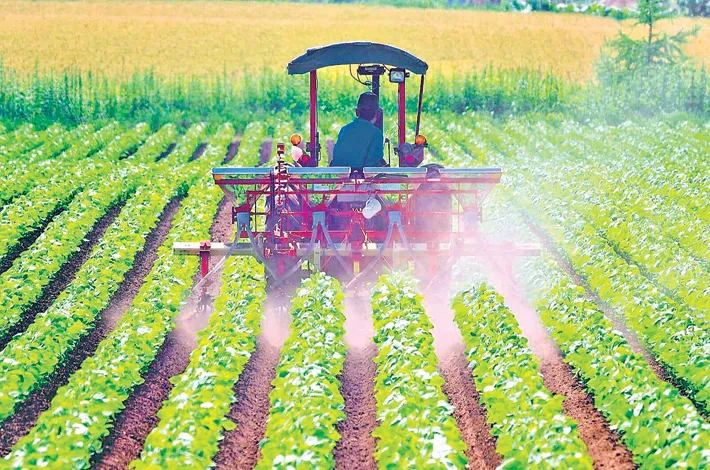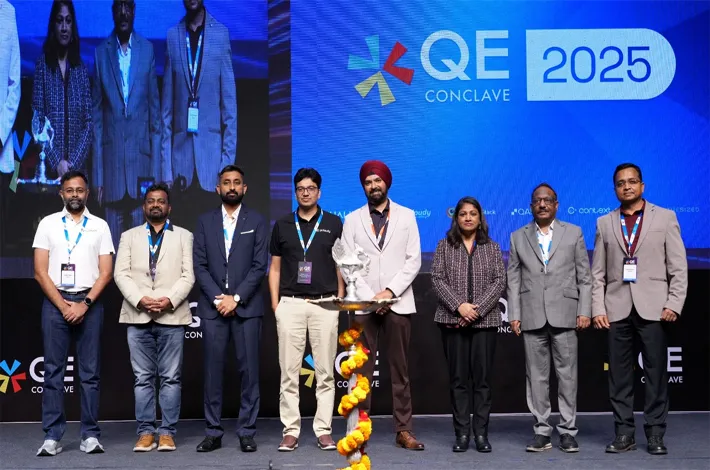TELANGANA VISION 2047
29-11-2025 12:00:00 AM

A USD 3 trillion innovation economy in the making
Telangana has set an ambitious goal of achieving a USD 3 trillion Gross State Domestic Product (GSDP) by 2047, positioning itself as India’s most dynamic, knowledge-driven economy. The strategy shifts from imitation to innovation-led growth, emphasizing human capital, productivity, and high domestic savings as the three reinforcing pillars.
Since its formation, Telangana’s nominal GSDP grew from Rs 5.1 lakh crore (USD 82 billion) in 2014–15 to Rs 15 lakh crore (USD 181 billion) in 2023–24, registering 12.7% annual nominal growth. Per capita income nearly tripled to Rs 3.87 lakh—1.9 times the national average—with a low Gini coefficient reflecting inclusive development. Services now contribute two-thirds of GVA and over 6% of India’s total services output.Growth Projections and Acceleration Needs
Under a business-as-usual scenario, GSDP would reach USD 1.2 trillion by 2047. To triple this to USD 3 trillion, the state must accelerate human capital formation and Total Factor Productivity by 1.75 times each and raise domestic savings to 50%. By 2047, services are projected to contribute 70% (USD 1.9 trillion), while industry and agriculture evolve into high-value, innovation-linked sectors.
Comprehensive strategies span IT and deep tech (AI, quantum, space), pharmaceuticals and life sciences, defence and aerospace (targeting USD 20 billion exports), semiconductors, EVs and clean mobility, agri-food processing, MSMEs, textiles and lifestyle, responsible mining, tourism (40 crore annual arrivals by 2047), and media/entertainment (positioning Hyderabad as South Asia’s night-time capital).
Strategic pillars include human capital with massive investments in education, skilling, health, and frontier research; productivity & innovation involving creation of a world-class science and technology ecosystem, led by the Telangana Scientific Return Program (TSRP) that attracts global scientists with grants, tax benefits, cutting-edge labs, and commercialization support; investment & saving measures such as fiscal discipline, deeper financial inclusion, and policies to channel savings into productive capital.
Telangana’s roadmap combines macroeconomic discipline, scientific excellence, global partnerships, and grassroots empowerment to deliver sustainable, inclusive, and innovation-driven growth, aiming to emerge as a global economic powerhouse by India’s centenary of independence.
Telangana strategic agricultural vision
Telangana’s transformative agricultural strategy aims to build a sustainable, profitable, climate-smart agri-food system by 2047 that doubles farmer incomes, ensures nutritional security, boosts exports, and generates widespread rural employment while engaging nearly half the state’s workforce. Key achievements upto 2025 include becoming the second-largest rice producer (1.53 crore tonnes) and leader in chilli, turmeric, and horticulture (42 lakh tonnes); Rs 20,617 crore farm loan waiver and rythu bandhu support for 25.35 lakh families; rapid diversification into oil palm, maize, pulses, millets, dairy, fisheries, and poultry.
Core enablers
IoT soil testing (40 lakh samples/season), micro-irrigation on 39.5 lakh acres, natural farming in 5,000 villages; 100 seed hubs, blockchain warehousing, AI logistics, and export facilitation port ; zero disease mission for livestock, Digi-Vet health monitoring, and 400 automated gaushalas . Strategic focus areas include climate-smart resilient ecosystem , Intensive farming & value-addition zones ; global seed leadership ; next-gen infrastructure; safe & nutritious food , livestock, diary and poultry; empowered farmer cooperatives; blue revolution, green forest livelihoods and also clean energy revolution.
Quantified targets by 2047 include increasing total agri production to 573 lakh metric tonnes from present level of 242 lakh metric tonnes , rice production to 392 lakh metric tonnes, horticulture fruit area to 20.3 lakh acres, milk to 107 lakh metric tones, fish to 22 lakh metric tonnes and farm power to 9 kW/ha
Carbon neutrality target by 2047
Telangana has launched one of India’s most comprehensive state-level climate strategies, pledging to achieve net-zero greenhouse gas emissions by 2047 while positioning itself as a global leader in sustainable and inclusive economic growth. The vision encompasses clean energy, climate-smart agriculture, restored forests, net-zero industries, and green urban systems, with an overarching goal of enhancing quality of life for all citizens.
The state already boasts impressive milestones: 11,399 MW of installed renewable energy capacity, over 2.6 billion trees planted under afforestation drives, more than 250,000 electric vehicles registered with full tax exemption, and India’s first Cool Roof Policy targeting 300 sq km by 2030. Over ₹1 lakh crore in green investments has been mobilized, while 31 new sewage treatment plants have helped Hyderabad move toward water positivity.
Looking ahead, Telangana plans to scale renewable capacity to 20,000 MW by 2030 and expand green cover to 50 percent of the state by 2047. Key initiatives include 19 GW of new solar and wind projects, a Ramagundam Green Hydrogen Valley, 6,000 public EV charging stations, and the creation of Telangana Mobility Valley as a global hub for electric vehicles and battery manufacturing. Hyderabad aims to host India’s largest electric bus fleet by 2030.
Industry will shift toward low-carbon parks, with over 1,600 polluting units already relocated and 80 percent of high-emission industries targeted for relocation by 2030. Agriculture will adopt water-saving rice cultivation techniques and solar-powered equipment, while waste management targets near-100 percent recovery through biomethanation, composting, and 200 MW of waste-to-energy capacity.
A dedicated Telangana State Net-Zero Authority and a Green Energy Transition Fund will coordinate efforts, supported by AI-enabled monitoring and an upcoming state carbon market. The plan also prioritises 500,000 new green jobs and reskilling programmes to ensure a just transition for workers in coal and high-emission sectors.
‘Rising Vision 2047’ blueprint
The Government of Telangana today released “Telangana Rising Vision 2047”, a comprehensive 25-year spatial and infrastructure roadmap that aims to transform the state into a top global innovation and investment destination while ensuring inclusive growth across urban, peri-urban, and rural areas. The vision is built on a polycentric framework that divides the state into three interconnected zones: the Telangana Core Urban Region (TCUR, 1.8% of land) centered on Hyderabad-the Peri-Urban Region (PUR, ~8.2%) for industrial and logistics expansion; and the predominantly rural Rest of the State (90%) focused on agrarian transformation and decentralized industries.
By 2047, every major settlement will be within two hours of the core urban region through high-speed connectivity. Despite being land-locked and facing challenges such as regional imbalance, rural migration, and low public-transit usage (currently below 28%), the plan leverages Telangana’s strengths: 25% forest cover, 61% agricultural land, two major river systems, and an existing radio-centric road-rail network of 11 radials and five rings.
Rural Telangana will see the launch of the Regional Cluster Acceleration Program, agro-industrial hubs at mandal headquarters, universal 24×7 water supply, mobile health clinics, and digitally connected village service centers to curb migration and create local jobs. Infrastructure targets are massive: national highways will expand from 4,983 km to 6,500 km, state highways to 8,600 km, and four new industrial corridors totaling 760 km.
A 12-lane greenfield expressway will link Bharat Future City directly to Machilipatnam port, while Rajiv Gandhi International Airport will scale to 80 million passengers annually.Chief Minister A. Revanth Reddy called Vision 2047 “a promise of dignity and opportunity for every citizen—whether in Hyderabad’s global hubs or the remotest village.” With inclusive skilling, heritage-led tourism, and aggressive decarbonization, Telangana aims to emerge as India’s most livable, competitive and sustainable state by its centenary of formation in 2047.








